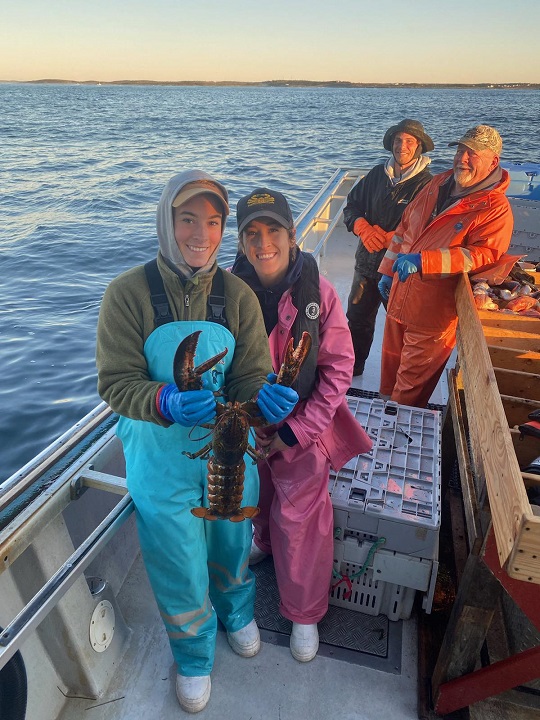Known worldwide for its fresh lobster, coldwater shrimp and succulent scallops, Atlantic Canada’s seafood industry has faced massive challenges since the outbreak of COVID-19.
The widespread travel restrictions and international border closures that were put in place to halt the spread of the virus have led to a dramatic drop in many seafood prices. It’s a bleak picture when you compare the first half of 2020 to 2019.
According to American market analysis company Urner Barry, the price of a 10- to 12-pound Atlantic salmon has dropped a whopping 44.6% between January and June of this year. Whole lobster prices also plummeted 42%, bringing the luxury catch down to $5.51 per pound from a robust $9.50 per pound in January.
This pricing landslide flies in the face of five years of promising growth in Canada’s lobster industry. Between 2015 and 2019, lobster exports grew a compound average rate of 6.2% , according to Statistics Canada. Last year was particularly rosy, when exports increased by 16.5%, thanks to booming sales to China brought on by the U.S.-China trade war.
Today, many businesses are being forced to get creative with their operation models in order to survive.
Unprecedented times
Coronavirus—and its impact on lobster prices—first became an issue on Jan. 24 for Nova Scotia-based Tangier Lobster Company. It was 6 a.m. when a Shanghai client sent an urgent email requesting a $1 per pound reduction on the shipment they were about to pack and send to him.
“I knew then that it was serious,” says Stewart Lamont, Tangier Lobster’s managing director, who also sits on the board of directors of the Nova Scotia Seafood Alliance. “He would never normally ask for a discount at the last minute like that.”
Wuhan, the epicenter of the COVID-19 outbreak, had just been locked down and the Chinese marketplace was suddenly slowing. “At first, it was the Asian marketplace—particularly China,” says Lamont. “Then the slowdown went into Europe, then North America. And then it was within the four walls of our company.”
Pandemic fallout in February and March made those months the toughest for Tangier Lobster. On Feb. 1, the selling price of lobster was half of what it had been in January. Canada had only reported its first case of coronavirus the week before. “Although we still had strong sales, price points were dramatically reduced,” says Lamont, who has been exporting lobster from the rural Tangier community since the 1980s.

While prices were falling, the company also had to prioritize keeping their employees healthy. Admittedly, they have a geographical advantage when it comes to physical distancing: their company sits on a 29-acre property about 100 kilometres outside of Halifax. They also have a gate, so they can control who enters their work environment and they all wear masks and keep a safe distance apart whenever possible.
Luckily, Nova Scotia’s succeeding in its battle against the virus and provincial restrictions are easing steadily. Lamont’s now waiting for the foodservice industry to rebound.
Around the world, public gathering spaces that make up a large portion of seafood sales—bars, restaurants, cruise ships, casinos, and hotels—have been shuttered by COVID-19, resulting in a staggering drop in worldwide consumption. Lamont estimates only 40% to 45% of the world seafood market has remained available to the industry.
When comparing March 2019 to March 2020, sales at Canadian restaurants plummeted by $3 billion, according to Ipsos’ Foodservice Monitor. But there are some positive developments: Instead of sitting in a restaurant, people are ordering takeout or getting restaurant meals delivered. The new online sales model has exploded everywhere, says Lamont, including mainland China, Hong Kong, Japan, South Korea, Kuala Lumpur, Singapore and Vietnam. “We have friends in the restaurant trade who are doing very serious online activity,” Lamont says, estimating online sales may have jumped as much as 10 times what they were last year.
New business models
One Australian salmon farming and processing company—Huon Aquaculture—has had success with their online Shopify store, allowing them to interact directly with their end consumers. Shopify provides an “ultimate guide” called How to Start a Food Business that includes information such as the Canadian food labelling requirements and a directory of Canadian food packaging manufacturers. They also have ready-built design themes that are perfectly suited to the seafood industry.
Being creative with what you’re offering your customers can also make a difference, says Edward Steeves, the regional vice-president of the Atlantic region at Export Development Canada (EDC).
“Not only are people improving their own internal sales models and online sales platforms, they’re also getting creative,” says Steeves. “They still offer their traditional commodity, but they’re also increasing the value-add to their products to make it more appealing to the direct consumer—whether that’s further processing or combining it with other products.” Businesses, like Huon, are creating hampers that offer smoked fish, pâté, and more.
Not only are people improving their own internal sales models and online sales platforms, they’re also getting creative.
One of the unexpected successes for Huon was from their “club”—an email list of loyal customers. These seafood enthusiasts have done more than just given them steady business—they’ve driven more sales than the company’s social media efforts.
Connecting directly with end-use clients may mean keeping more money in your pocket compared to suppliers who use brokers, distributors and resellers. But it also comes with its own risks and extra work, according to the Fishermen’s Direct Marketing Manual, put out by the Alaska Seafood Marketing Institute. Of course, there are options to reduce that risk through your financial institution and EDC.
Lamont says many in Nova Scotia’s seafood industry are relieved to know they can get help if they need it, says Lamont. “The government has stepped up, banks have stepped up and Export Development Canada has stepped up,” he says.
Help for pandemic challenges
In the first few weeks of the pandemic, EDC put together a brand-new credit program for companies selling within Canada or internationally. Called the EDC Business Credit Availability Program (BCAP) Guarantee, it was designed to help address cash flow challenges caused by the COVID-19 pandemic.
To roll out the guarantee, EDC partnered with financial institutions across the country, helping Canadian business owners cover operating costs. EDC has also adjusted several of its financial solutions to reflect these tough times, implementing new measures that include deferring payments, increasing credit limits and committing to faster approval processes.
But there are other benefits to giving EDC a call, says Steeves. Canada’s credit agency has global representation in more than 20 offices around the world, including many that are experiencing a growing demand for seafood. Seafood companies can use EDC to get on-the-ground information about opportunities for expansion into these new, profitable markets.
“We can walk them through the nuances of various markets and leverage our relationship with Global Affairs Canada,” says Steeves. Global Affairs offers a Trade Commissioner Service that can connect Canadian business owners with international trade shows and events, as well as share in-depth knowledge of international seafood markets.
Seafood stabilization fund
Another financial resource for seafood businesses is the Government of Canada’s Canadian Seafood Stabilization Fund, offering $62.5 million to the fish and seafood processing sector to weather losses caused by COVID-19. For Nova Scotia and the rest of Atlantic Canada, the program’s being managed by the Atlantic Canada Opportunities Agency (ACOA).
Lamont says he has a lot of empathy for seafood businesses that are experiencing a cash flow crunch. Early on in the pandemic, his company decided to close down anything that wasn’t a “must” in order to minimize costs as much as possible. That meant initiatives that weren’t directly tied to immediate sales were put on hold.
“We should be under no illusions that it’s business as usual or life as usual,” says Lamont. “But so far, the lobster sector has survived.”
As global economies reopen, many businesses looking to recover and pivot to non-traditional business models that work in the “new normal” will turn to government resources and EDC for support.




